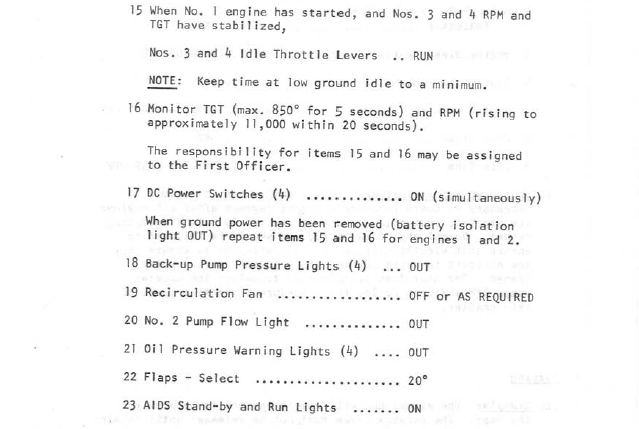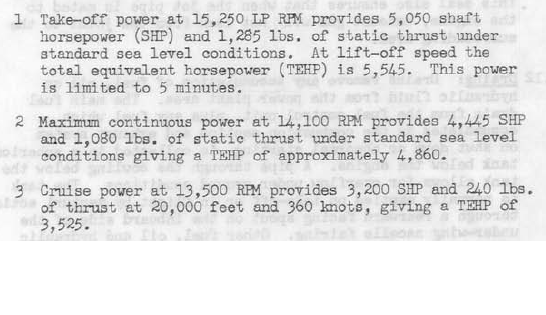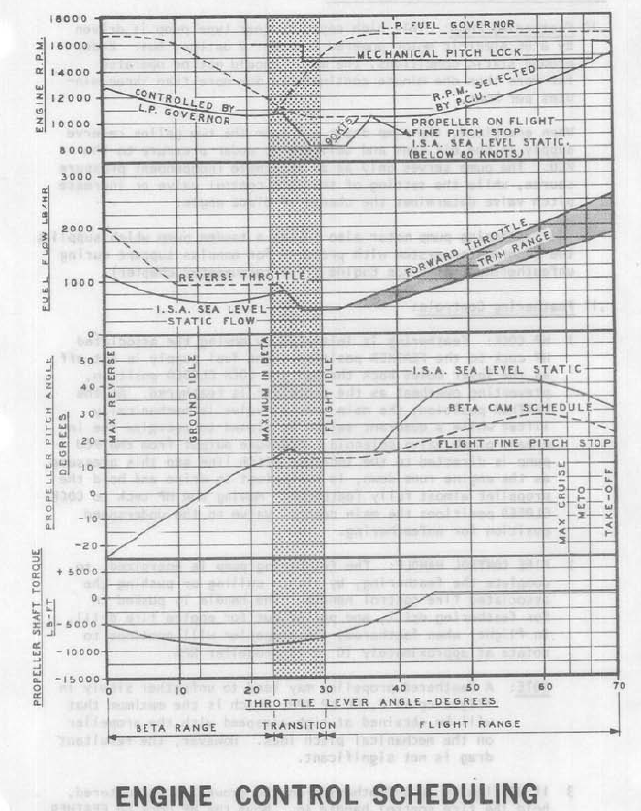Vanguard limiting speeds
Jhieminga,
Were the Vanguards Tynes fitted with electric starter motors or did it have air turbine starters,
Running the risk of drifting the thread, I'll bet the Vanguard, like all big turboprops almost never needed brakes on landing - pull those props back into fully fine or even reverse pitch and they STOPPED!
Same in flight too (not reverse though!) high speed until very close in, back to idle, props would go into fine pitch and off came the speed.
Happy days.
Were the Vanguards Tynes fitted with electric starter motors or did it have air turbine starters,
Running the risk of drifting the thread, I'll bet the Vanguard, like all big turboprops almost never needed brakes on landing - pull those props back into fully fine or even reverse pitch and they STOPPED!
Same in flight too (not reverse though!) high speed until very close in, back to idle, props would go into fine pitch and off came the speed.
Happy days.
Electric starters. You could start up from batteries or using a GPU (as shown in my photo above). In later years the 'PEP team was limited to battery starts only as they didn't have a GPU available at the museum. I understand that only the Vanguard and the Belfast used electric starters on the Tynes, the other types all had air starters fitted. I looked back over some old posts about G-APEP and I found some links to an engine run on 31st October 2009.
The shutter speed for these videos led to the props appearing to turn really slowly, but I'm sure that they're at low ground idle at least. Also, the image looks a bit squashed horizontally.
This video from 2008 is better, but still doesn't show the correct rpm for the props:
Right, I should add these as well, the last landing of G-APEP at Brooklands (they ended up a bit short...) and the last time the Vanguard taxied on the Brooklands runway. As for stopping a Vanguard, it is worth pointing out that it landed on the northern half of the runway as Wellington Way had been constructed by then. Because of this, only about 60% of the original runway was available for her to land on.
This video from 2008 is better, but still doesn't show the correct rpm for the props:
Last edited by Jhieminga; 14th Feb 2022 at 10:46. Reason: More videos...
"Mildly" Eccentric Stardriver
Hi bean, The talk on crossover led me to take a look at "Handling the Big Jets", by D.P. Davies, once Chief Test Pilot for the ARB. The book is probably long out of print, my own copy being one I was given in '75. There is a graph, which I don't think I can insert, of descent speeds. He is using Mmo 0.88, Vmo 330. The crossover on his graph is at 31,000', with "coffin corner" at 50,000.
Having said that, I'll shut up. My turbo-prop experience is C-130 and F-27, so I have nothing further of value to add to this thread. However, I'll continue to follow you all; always something to learn.
Having said that, I'll shut up. My turbo-prop experience is C-130 and F-27, so I have nothing further of value to add to this thread. However, I'll continue to follow you all; always something to learn.
The HP RPM gauges were located to the right of the F/O`s seat. Above his head was the start panel - with a master start switch & four individual start switches. In front of the throttles were 4 start levers. In the START position they allowed a limited fuel flow to the engines. In the NORM position they increased the flow to normal. The transition took several seconds - the indicators would change from START to crosshatch to NORM during the transition. The engine starter was electric and engaged with the HP spool for starting. Starter cutout was automatic when the HP spool reached approx 4000 RPM. The start sequence was eng 4-3-2-1 (can`t remember why).
For BEA operation the sequence and call outs were:
P1: Start 4.
P2: Master start on, starting 4.
P2: HP turning . . . LP turning . . . 3000 (HP RPM).
P1: (Selects Fuel Cock OPEN)
P1: Fuel flow normal . . . Light up.
P2: 4000 . . . Starter cutout . . . Starter light out.
P1: 4 stable . . . Start 3 (&c)
The engine stabilised at low ground idle. Then P1 would move the start lever to RUN.
P2: 4 running (indicator cross hatch).
P1 would monitor turbine gas temp, which would rise during RPM increase and then drop back as the engine stabilised at ground idle. When all engines were running at ground idle the master start switch was selected off by P2.
I can’t remember the prop RPMs at low ground idle (when you could see the individual blades) and ground idle (when they turned into a blur). Cruise prop RPM was in the region of 900 IIRC, with LP RPM 12,500.
More Vanguard trivia in ‘The Damocles Plot’.
Last edited by Discorde; 12th Mar 2022 at 14:39. Reason: start lever annotation corrected
On C-130s,the inboard engines were started first,then outboards....logic was ,if an inboard caught fire,you could fight it without having a whirling prop to get past...
Vanguard eng start (from memory):
The HP RPM gauges were located to the right of the F/O`s seat. Above his head was the start panel - with a master start switch & four individual start switches. In front of the throttles were 4 start levers. In the START position they allowed a limited fuel flow to the engines. In the RUN position they increased the flow to normal. The transition took several seconds - the indicators would change from START to crosshatch to RUN during the transition. The engine starter was electric and engaged with the HP spool for starting. Starter cutout was automatic when the HP spool reached approx 4000 RPM. The start sequence was eng 4-3-2-1 (can`t remember why).
The HP RPM gauges were located to the right of the F/O`s seat. Above his head was the start panel - with a master start switch & four individual start switches. In front of the throttles were 4 start levers. In the START position they allowed a limited fuel flow to the engines. In the RUN position they increased the flow to normal. The transition took several seconds - the indicators would change from START to crosshatch to RUN during the transition. The engine starter was electric and engaged with the HP spool for starting. Starter cutout was automatic when the HP spool reached approx 4000 RPM. The start sequence was eng 4-3-2-1 (can`t remember why).
I think most UK built four engined turboprop aircraft started number three engine first, followed by number two, four and then one. I am sure we used this order on the Britannia and Argosy.
Thread Starter
Hi Brakedwell. Most of the Viscounts i ever saw, and there were many, stsrted 4321
IIRC the Viscount 700s had hydraulic pumps on the outboard engines and the 800s had them on the inboards. Not sure if that affected the start sequence, but when taxiing in the 700s used 1 and 4 and the 800s used 2 and 3.
Electra (not British) always started no 4 first as that was the only engine with a 2 speed gearbox for the generator, so that all ground equipment could be removed, (GPU and air start), before up shifting to crossbleed start the other engines.
Electra (not British) always started no 4 first as that was the only engine with a 2 speed gearbox for the generator, so that all ground equipment could be removed, (GPU and air start), before up shifting to crossbleed start the other engines.
IIRC the Viscount 700s had hydraulic pumps on the outboard engines and the 800s had them on the inboards. Not sure if that affected the start sequence, but when taxiing in the 700s used 1 and 4 and the 800s used 2 and 3.
Electra (not British) always started no 4 first as that was the only engine with a 2 speed gearbox for the generator, so that all ground equipment could be removed, (GPU and air start), before up shifting to crossbleed start the other engines.
Electra (not British) always started no 4 first as that was the only engine with a 2 speed gearbox for the generator, so that all ground equipment could be removed, (GPU and air start), before up shifting to crossbleed start the other engines.
CL44: (RR Tyne 515 mk. 12) start sequence 2 then 1. With 2 & 1 running in low ground idle, accelerate into high ground idle. When stable, generators (via CSDs) cabin supercharger (#2 and #3) on line and then same process for 3 & 4. As a result, some time would elapse after 2 & 1 were started before starting 3 & 4 could begin.
Air turBine starters powered only by a ground air start unit- not from the pneumatic manifold.
Max weight take-off one fine morning from Mombasa, with 2 & 1 running the ground crew disconnected the air start and cleared off. By the time it was brought back, the temp had risen too high to allow take-off. Back to the hotel until early evening when the temperature hsd dropped!
Air turBine starters powered only by a ground air start unit- not from the pneumatic manifold.
Max weight take-off one fine morning from Mombasa, with 2 & 1 running the ground crew disconnected the air start and cleared off. By the time it was brought back, the temp had risen too high to allow take-off. Back to the hotel until early evening when the temperature hsd dropped!
My memory wasn't playing tricks on me. Merchantman at Liverpool, 1995:
Interesting to note that, as well as No 3 being started first as per my recollection (9:00), taxy in after landing was on the outers only (1:30).
Interesting to note that, as well as No 3 being started first as per my recollection (9:00), taxy in after landing was on the outers only (1:30).
Drift of thread here, but did the first generation jets (707 and DC8) start 3,4,2,1? I seem to recall they did but the memory might be playing tricks.
Interesting to note that, as well as No 3 being started first as per my recollection (9:00), taxy in after landing was on the outers only (1:30).
permitted T/O LP RPM range 15,050 (min) to 15,500 (max)
max continuous HP RPM 17900
Except at high airports temps min torque for take off was 430 units (engines 2 & 3) and 450 for 1 & 4. This was because the inners also powered the pressurisation compressors. During conversion to Merch config the eng 2 compressors were removed, presumably to reduce costs. At high airport temps the HP cock trimmers were set to lower settings, which of course reduced the min required T/O torques.
It looks like the TCA Vanguards cruised at higher LP RPM than BEA. Maybe fuel economy (and maintenance cost) was less critical in those days.








